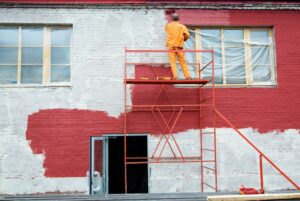Industrial painting is not just about applying a coat of paint. It’s a vital process that helps protect infrastructure, machinery, and equipment from wear and tear while improving their appearance. Whether you’re managing a factory, a warehouse, or a refinery, industrial painting services are key to keeping your workspace safe, durable, and visually appealing.
In this article, we’ll explore everything you need to know about industrial painting services. We’ll cover the process, benefits, types of paints used, and why hiring professionals is essential. Let’s dive into this colorful world and discover how industrial painting makes a big difference.
What Are Industrial Painting Services?
Industrial painting services involve specialized painting techniques applied to commercial and industrial structures. This type of painting is typically performed on surfaces exposed to harsh conditions, such as heavy machinery, steel beams, and pipelines. The aim is to provide protection against rust, corrosion, chemicals, and wear, while also enhancing the aesthetic appeal of the space.

But industrial painting is more than just aesthetics. Imagine it as the armor protecting your infrastructure. Without it, equipment would succumb to corrosion, and structures would lose their integrity much faster.
Why Industrial Painting Matters
Why should businesses care about industrial painting services? It’s simple: longevity. Industrial spaces and equipment are constantly exposed to elements that can cause deterioration. By applying industrial-grade coatings, companies can extend the lifespan of their assets. Would you drive your car without ever servicing it? Of course not! Similarly, industrial painting is like maintenance that keeps your machinery and facilities in top condition.
The Key Benefits of Industrial Painting
Industrial painting goes beyond the basics of “just painting.” Let’s explore some key benefits:
1. Protection from Environmental Factors
Industrial painting acts as a barrier, protecting surfaces from moisture, extreme temperatures, and chemicals that could cause damage.
2. Enhanced Durability
By reinforcing surfaces with specialized coatings, industrial painting helps machinery and structures withstand the wear and tear of daily operations.
3. Improved Safety
Certain paints are designed to make environments safer. Anti-slip coatings and fire-retardant paints are just a couple of examples.
4. Aesthetic Appeal
While safety and durability are priorities, the aesthetic value should not be overlooked. Clean, well-painted surfaces give off a professional appearance, which can boost employee morale and leave a good impression on visitors.
Types of Paints and Coatings
Not all paints are created equal, especially when it comes to industrial applications. Here are some of the most commonly used industrial paints and coatings:
1. Epoxy Coatings
Epoxy is known for its resistance to chemicals and abrasions, making it ideal for industrial floors and heavy machinery.
2. Polyurethane Paints
Polyurethane is highly durable and resistant to UV light, making it perfect for outdoor applications where sun exposure is a concern.
3. Acrylic Paints
Acrylic paints are versatile and fast-drying, often used in areas with high traffic because they can withstand frequent cleaning.
4. Zinc-Rich Primers
Used for corrosion protection, zinc-rich primers create a protective layer on steel surfaces, preventing rust.
Surface Preparation: The Foundation for Success
The first and arguably most important step in industrial painting is surface preparation. This involves cleaning, sanding, or blasting surfaces to remove dirt, rust, or old paint. Why is this so important? Think of it like laying a foundation for a house. If the foundation is weak, the house will collapse. Similarly, improper surface preparation can lead to peeling paint and other problems down the road.
Common methods include:
- Sandblasting: Removes contaminants through high-pressure abrasive material.
- Pressure Washing: Cleans surfaces of dirt and debris using water at high pressure.
- Chemical Cleaning: Involves solvents to break down grease or oil.
The Industrial Painting Process: Step-by-Step
Let’s walk through a typical industrial painting process:
Step 1: Inspection
Before any work begins, professionals assess the surfaces to determine the best course of action. Factors like surface material, exposure to elements, and existing damage are taken into consideration.
Step 2: Surface Preparation
As mentioned earlier, preparing the surface is critical. Once the surface is clean and smooth, it is ready for the primer or coating.
Step 3: Application of Primer
A primer is applied to ensure the paint adheres properly and provides long-lasting protection. For metal surfaces, zinc-rich primers are commonly used to prevent corrosion.
Step 4: Painting or Coating
This is the fun part. Painters apply the chosen coating using brushes, rollers, or spray equipment. The method depends on the size and type of surface.
Step 5: Final Inspection
Once the paint is dry, a final inspection ensures there are no flaws or weak spots. Touch-ups are made if necessary, ensuring the finish is perfect.
Common Industries that Rely on Industrial Painting
You might be wondering, “Who uses industrial painting services?” The short answer: a lot of industries. Here are some of the most common:
- Manufacturing Plants: To protect machinery and structures from corrosion and wear.
- Oil & Gas Refineries: To shield against chemicals, moisture, and extreme temperatures.
- Warehouses: To maintain a clean and safe environment.
- Food & Beverage Plants: Specialized paints are used to comply with health and safety regulations.
Hiring Professional Industrial Painters: What to Look For
Hiring a professional team for industrial painting services is essential to get the job done right. But what should you look for in a company?
1. Experience and Expertise
Choose a company with a proven track record in industrial painting. Ask for references and case studies to ensure they have experience in your industry.
2. Certifications
Look for companies that hold certifications in health, safety, and environmental protection. These certifications demonstrate a commitment to quality and safety.
3. Equipment and Techniques
Ensure the team uses modern equipment and techniques, such as electrostatic painting or airless spraying, for better coverage and a smoother finish.
Safety Considerations in Industrial Painting
Safety is paramount in any industrial setting. With industrial painting, safety considerations include:
- Proper Ventilation: Paints and coatings can release harmful fumes.
- Protective Gear: Workers must wear gloves, masks, and protective suits.
- Fire Safety: Some paints are flammable, so fire prevention measures are crucial.
How to Maintain Industrial Paintwork
Once the paint is applied, maintenance is key to ensuring it lasts. Here are some tips:
- Regular Inspections: Check for any signs of wear, peeling, or corrosion.
- Cleaning: Use non-abrasive cleaners to keep painted surfaces clean.
- Touch-ups: Address any small damages or chips before they grow into bigger issues.

Cost of Industrial Painting Services
The cost of industrial painting services can vary depending on several factors:
- Size of the Area: Larger areas will naturally cost more to cover.
- Type of Paint or Coating: Some specialized coatings, like fire-resistant paint, are more expensive.
- Surface Condition: If significant surface preparation is needed, it can add to the cost.
Conclusion:
In conclusion, industrial painting services are crucial for protecting, maintaining, and improving industrial spaces. Whether you’re looking to protect your infrastructure from the elements, ensure safety, or enhance the appearance of your facility, professional industrial painters offer expertise and solutions tailored to your needs. Think of industrial painting as an investment — one that pays off by extending the life of your equipment and facilities.
FAQs
1. What is the difference between industrial painting and commercial painting?
Industrial painting is designed for facilities and equipment exposed to harsh conditions, while commercial painting typically focuses on aesthetic improvements in public-facing spaces like offices or retail stores.
2. How long does industrial paint last?
The lifespan of industrial paint depends on the type of coating and the environment it’s exposed to. Generally, industrial paint can last anywhere from 5 to 15 years with proper maintenance.
3. Can industrial painting be done on operational equipment?
Yes, in many cases, industrial painting can be done on operational equipment. However, safety measures must be in place to ensure minimal disruption to operations.
4. What types of surfaces can be painted with industrial coatings?
Industrial coatings can be applied to various surfaces, including metal, concrete, and wood. The type of paint will depend on the surface material and environmental factors.
5. Why is surface preparation so important in industrial painting?
Surface preparation is critical because it ensures that the paint adheres properly to the surface. Without proper preparation, paint can peel, chip, or wear prematurely.



